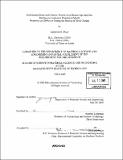Multifaced stone and ceramic moulds from Bronze Age Anatolia : building an analytical protocol of mould properties and behavior during the process of metal casting
Author(s)
Biçer, Katherine K. (Katherine Kershen)
DownloadFull printable version (15.16Mb)
Other Contributors
Massachusetts Institute of Technology. Dept. of Materials Science and Engineering.
Advisor
Heather Lechtman.
Terms of use
Metadata
Show full item recordAbstract
A three phase analytical protocol is developed to systematize the study of multifaceted serpentinite bronze-casting moulds from Bronze Age Anatolia (ca. 3500-1700 B.C.). These moulds represent a class of metal processing tools that reflect material properties and perhaps also social concerns in their development and use. In phase I of the protocol, standard serpentinite tiles are heated to known temperatures and the crack density and ineral changes at each temperature are determined using scanning electron microscopy (SEM) and energy dispersive x-ray (EDX) analysis. These results then serve to calibrate the cracking and mineralogical behaviors of serpentinite replica moulds used in controlled casting experiments during phase II. Metallography on several phase II cast objects provides additional information on heat flow through the stone. In phase III, the protocol is modified appropriately for the non-destructive study of four archaeological moulds using x-ray diffraction (XRD), x-ray fluorescence (XRF), and SEM. The applicability of the protocol to other stone and ceramic materials is discussed.
Description
Thesis (S.M.)--Massachusetts Institute of Technology, Dept. of Materials Science and Engineering, 2005. Includes bibliographical references (leaves 91-96).
Date issued
2005Department
Massachusetts Institute of Technology. Department of Materials Science and EngineeringPublisher
Massachusetts Institute of Technology
Keywords
Materials Science and Engineering.